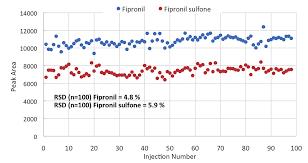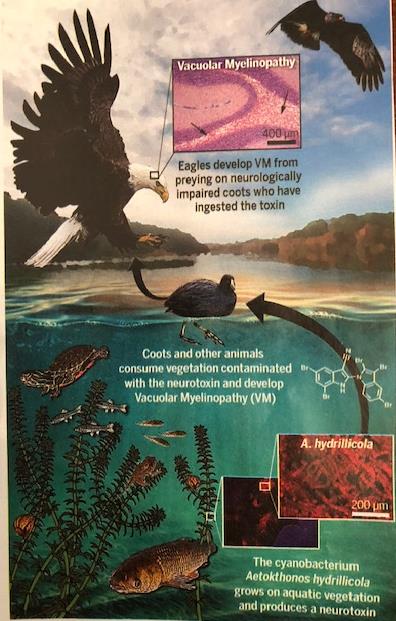 In 1994 the U.S. Geological Survey and wildlife biologists affiliated to universities and federal laboratories investigated ascending mortality in Bald Eagles. It was determined that eagles that demonstrated incoordination and paralysis before death showed vacuolar myelinopathy on histological examination of brain tissue. Initial studies showed that coots and owls were also affected showing similar lesions. Initial investigations ruled out industrial waste and pesticides as possible etiologic factors.
In 1994 the U.S. Geological Survey and wildlife biologists affiliated to universities and federal laboratories investigated ascending mortality in Bald Eagles. It was determined that eagles that demonstrated incoordination and paralysis before death showed vacuolar myelinopathy on histological examination of brain tissue. Initial studies showed that coots and owls were also affected showing similar lesions. Initial investigations ruled out industrial waste and pesticides as possible etiologic factors.
 Most recently Dr. Susan Wilde, an aquatic ecologist at the University of Georgia, in Athens has demonstrated the sequence of events leading to the fatal outcome in a range of bird species*. An aquatic plant Hydrilla verticillata is fast-growing and invasive, especially in waterways in the Mid-Atlantic and Southeast. A cyanobacterium Aetokthonos hydrillicola was identified in 2014 associated with Hydrilla. The cyanobacterium does not however develop the neurotoxin without the presence of bromine. Sources of this element include fly ash from coal-fired power plants, flame-retardant chemicals that enterrivers and dams, fracking fluids, and road salt. A possible source is diquat dibromide herbicide that is in fact used to suppress Hydrilla.
Most recently Dr. Susan Wilde, an aquatic ecologist at the University of Georgia, in Athens has demonstrated the sequence of events leading to the fatal outcome in a range of bird species*. An aquatic plant Hydrilla verticillata is fast-growing and invasive, especially in waterways in the Mid-Atlantic and Southeast. A cyanobacterium Aetokthonos hydrillicola was identified in 2014 associated with Hydrilla. The cyanobacterium does not however develop the neurotoxin without the presence of bromine. Sources of this element include fly ash from coal-fired power plants, flame-retardant chemicals that enterrivers and dams, fracking fluids, and road salt. A possible source is diquat dibromide herbicide that is in fact used to suppress Hydrilla.
It is evident that the neurotoxin accumulates in the food chain extending from fish that consume Hydrilla radiating upwards to predators with eagles at the apex. Coots that consume Hydrilla are also affected and dead carcasses are scavenged by eagles that ingest the toxin.

An approach that has been used to interdict the chain of toxicity includes stocking lakes containing Hydrilla with sterile grass carp that consume the weed without producing any residue. The Army Corps of Engineers released fish into a reservoir in South Carolina resulting in consumption of the Hydrilla weed allowing recovery of the bald eagle population.
Identifying the relationship between the cyanobacterium, the water weed, fish, and bird predators will be useful in preventing additional mortality in eagles in other areas. It is inevitable that Hydrilla will be spread by boats and possibly migrating birds and that the cyanobacterium will infect the Hydrilla.
The studies conducted by Dr. Wilde and  her colleagues represent an elegant model of the interrelationship of a bacterium, a plant host, and the ultimate effect on the apex bird in the ecosystem. Studies are currently in progress to determine whether the neurotoxin can affect mammals since there may be potential human health considerations with bioaccumulation in fish.
her colleagues represent an elegant model of the interrelationship of a bacterium, a plant host, and the ultimate effect on the apex bird in the ecosystem. Studies are currently in progress to determine whether the neurotoxin can affect mammals since there may be potential human health considerations with bioaccumulation in fish.
*Breinlinger, S et al. Hunting the Eagle Killer: A Cyanobacterial neurotoxin causes vacuolar myelinopathy. Science doi.org/10.1126/science.aax9050.